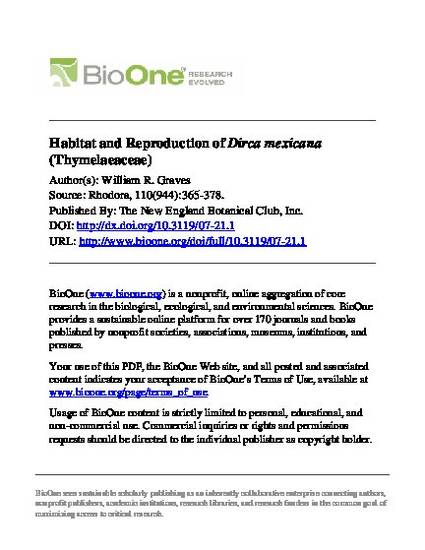
Article
Habitat and Reproduction of Dirca mexicana (Thymelaeaceae)
Rhodora
Document Type
Article
Publication Version
Published Version
Publication Date
1-1-2008
DOI
10.3119/07-21.1
Abstract
Little is known about the single reported population of Dirca mexicana. I monitored air temperature from mid-2005 through mid-2007, analyzed pH of soil, used the global positioning system (GPS) to define geographical boundaries of the population, explored for additional populations, and studied aspects of sexual and asexual reproduction in situ and among seedlings in greenhouses. Temperature ranged from −2 to 35.5°C, and weekly means were 7.4 to 18.1°C. Soil pH was 6.3. No other populations were found at sites nearby with similar slopes and aspects, but a second distinct cluster of plants was found 221 m from the portion of the known population described previously. Numerous individuals of Catasticta nimbice nimbice, a butterfly in the family Pieridae, visited flowers in mid-March, 2007. Drupes were observed in May four of five years, and drupe count per plant was 3 to 131 among individuals with basal trunk diameters of 10 to 46 mm in 2007. Genetic analysis of 45 individuals revealed no putative clones. Drupes of D. mexicana were longer and wider than those of the other two species in the genus, while size of seeds was intermediate. Seedlings isolated from pollinators in a greenhouse flowered for the first time and formed viable seeds during their fourth spring of development, demonstrating the capacity of D. mexicana to self-pollinate or to form seeds via apomixis. These observations improve our understanding of the habitat and reproductive biology of this endemic species.
Copyright Owner
New England Botanical Club
Copyright Date
2008
Language
en
File Format
application/pdf
Citation Information
William R Graves. "Habitat and Reproduction of Dirca mexicana (Thymelaeaceae)" Rhodora Vol. 110 Iss. 944 (2008) p. 365 - 378 Available at: http://works.bepress.com/william_graves/12/

This article is from Rhodora, 110(n.944)2008; 365-378. doi: 10.3119/07-21.1. Posted with permission.